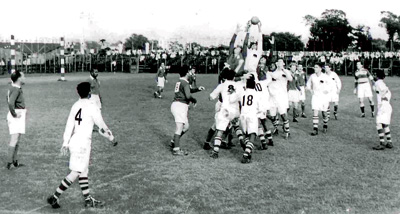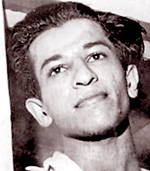The Rt. Royal Ashy Cader defied the laws of gravity
View(s):Appreciation
By M.V. Muhsin
If Sri Lanka rugby had a Hall of Fame, there is no question that Ashroff ‘Ashy’ Cader would have been occupying it without peer in the very front row for sixty years. And if among those celebrities there was one who was admired for his leadership as the Captain of the Ceylon Team for his prowess, finesse and style as a No. 8 forward, and for his debonair and dashing looks, it had to be Ashy Cader. He was such a complete player and the heart-throb of generations of ruggerites.
 Ashy, who passed away in Melbourne Australia this week at the age of 85, was captain of Royal and the CR&FC and of Ceylon, as our country was then called. He is truly a legend. To begin at the beginning: Royal was playing Trinity in Kandy for the Bradby Shield in 1948. Trinity led by Azwer ‘Kadja’ Mohamed, were firm favourites, and Royal had 12 freshmen in its side.
Ashy, who passed away in Melbourne Australia this week at the age of 85, was captain of Royal and the CR&FC and of Ceylon, as our country was then called. He is truly a legend. To begin at the beginning: Royal was playing Trinity in Kandy for the Bradby Shield in 1948. Trinity led by Azwer ‘Kadja’ Mohamed, were firm favourites, and Royal had 12 freshmen in its side.
In those days the teams had to walk through the street of Kandy to get to the Bogambara grounds. It was a ‘long walk’ for the less fancied Royalists. The staunchly partisan Kandy fans taunted them. In an interview that the writer had with him in 2012, Ashy recalled that the jibes intensified as they approached the market:
“Aney Mahathuru, match ekata yande epa, bada yanakan dei” (gentlemen, please don’t go for the match you will get beaten till you purge!). I’ll teach them a lesson Ashy said under his breath.
Royal won the match and the Bradby Shield! It was a major upset.
 No ‘lifting’ for forwards
No ‘lifting’ for forwards
From that point on Ashy’s rise in the rugby firmament was meteoric. Here was a No. 8 forward –6 ft 2 inches tall—who put his physicality and rugby dynamism to optimal use. Those were days when as a line out forward there was no ’lifting’; and one had to defeat the forces of gravity with one’s own power. And Ashy did that with such elegance that Newtonian theories were challenged to the hilt.
We watched him with awe. Playing for CR&FC, he out-jumped everybody, and as Ashy recalls, there were many tall and lanky ‘Suddahs’(white men) in CH & FC and in the Up Country teams which were expatriate dominated, with many a six footer and stronger players. But Ashy proved that height and brawn were but a few of the factors and that skill and guile had to be brought into play as he delivered quality ball to his team, disrupting throws by the opposing team and out-maneuvering them in myriad ways.
He played hard and smart
As there were cross-hairs aimed at him, it was important for Ashy to develop counter-attacks. For instance, as he towered above others to collect ball, Mahes Rodrigo and he plotted to turn inwards and pass the ball within the team and then break out into the open side.
Occasionally force was also at play. In a match between the CR and Up-Country, there was a crucial line out near the five-yard line, and Barry Cameron of Dimbulla created a commotion. Devaka Rodrigo the CR forward asked Barry what the matter was. Barry blurted out saying “your bloody Captain bit me, see his teeth marks on my thigh!”
Referee Flt. Lt Lloyd who was now in the midst of the fracas heard Devaka rising to the defence with a pungent quip that the Rodrigo’s were renowned for: “get lost, chum, our Captain Ashy Cader’s religion does not permit him to eat ‘hogs’ like you!” Humoured by this, Ref Lloyd puts his arm around Devaka and invited him for a drink after the match.
In a way it was Devaka, Ashy recollects, who was instrumental in getting him to take rugby seriously. When Ashy had decided to take a break of one year from Rugby in 1949, Devaka pleaded, “ get back to rugby. I assure you that you’ll be a sensation!
And as sensations went, Ashy played for Ceylon in his first year of club rugby. Ken de Joodt, a glamorous ruggerite, in his own right, recalls: It was the All-India match played in Calcutta where the big, burly British Tea Planters from South India were intent in using bullying tactics to put the ‘fear of Moses’ into us who were much smaller players, like me. Ashy asked us to have the mind-set of a pack of lions, play cool, not get ruffled, watch for the opportunities; use skill, be quick, and run hard and slip past and pounce…it surely paid off”.
No wonder that with lion-like ferocity and alacrity the Ashy led Ceylon team over-powered the opposition in their own den. De Joodt sums up eloquently: “Ashy had the image of a ‘Champion’ inside him, knowing deep down in his heart that he was a victor—not a victim.”
Ashy’s coaching recognised
Keen to give something back to future generations, Ashy took to coaching. The Alumni of Isipathana Maha Vidyalaya fittingly acknowledged his lasting contribution at a Re-union dinner in Melbourne. They had struck the school’s rugby scene in Sri Lanka with bolts of lightning that blazed a new trail.
As Ashy and his wife Estelle walked in, the band stopped playing: there were spontaneous cheers from the audience for a man who taught the Pathanians to move away from stereotyped rugby and play an attacking game, steam-roll the opposition and resort to hard, tactical, fast moving play. No wonder the Isipathan haunt Royal and Trinity and St. Peter’s to this day with the Pathanian nightmare.
At the CR, the Ashy led 1958 side was unbeaten and comprised a host of well-known players. Ashy brought much repute to his club, the CR&FC, and to his employer Walkers. Following a weekend victory that Ashy led, Anthony ‘Johnny’ Walker, who owned Walkers called him into the office and said: “Ashy I am promoting you to head the Lucas business; don’t worry about the Suddhas (white guys) who will all be upset. You have brought such repute to our company and you are a capable executive as well.”
It was Kavan Rambukwelle who aptly described Ashy as “Primus inter pares (first among equals) and that Ashy was that “Adonis” who left an indelible imprint on the greens of Ceylon and India; Had he played Rugby in any other country I am certain, wrote Kavan, he will have knocked on the door of representative honours.
Ashy duly recognised
But Ashy’s international acknowledgement came in a curious way. He was casually reading the newspapers at the Australian Embassy in Colombo when the Consul General spotted him and inquired: aren’t you Ashy Cader? They chatted and then the question came: Are you interested in migrating to Australia? Well, I came here to read the newspapers and the thought had not occurred to me, replied Ashy. The Consul goes into his office and brings an application form and says ” we need stars like you in our country”. If you are interested, fill this up and bring it to me. Within two weeks a resident visa was granted to Ashy and his family.
Stars such as Ashy brightened the Sri Lanka rugby scene with the luminosity that few others have done in our generation.
Mohamed Muhsin e mail : Mohamed@mvmuhsin.com


